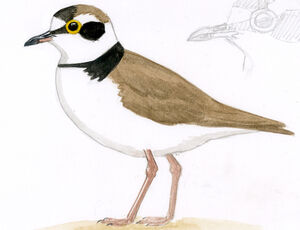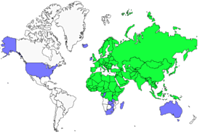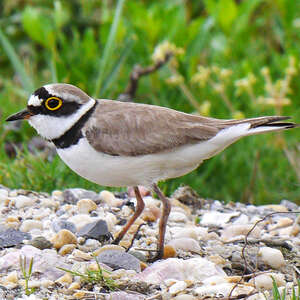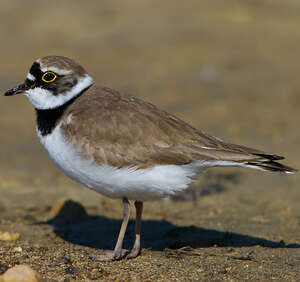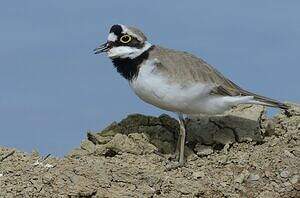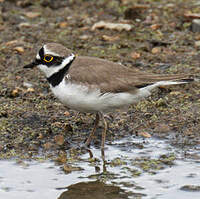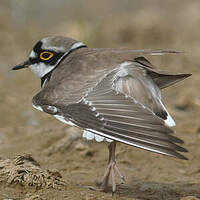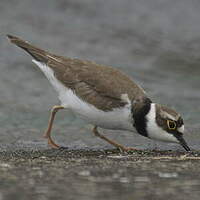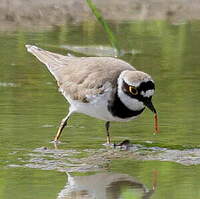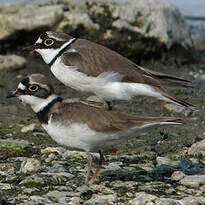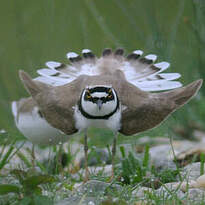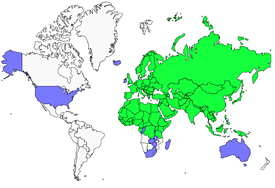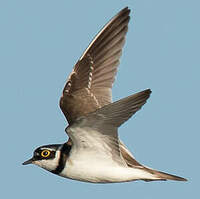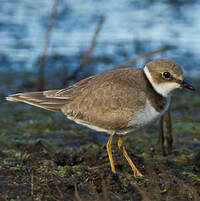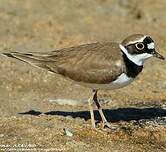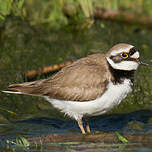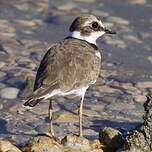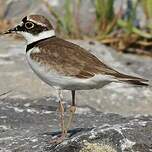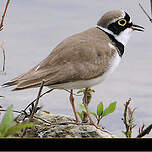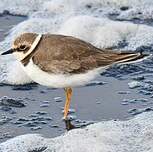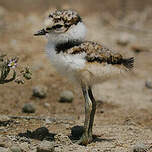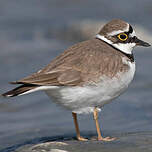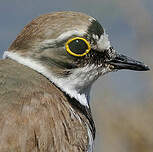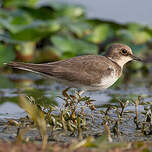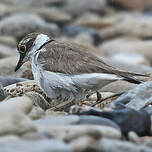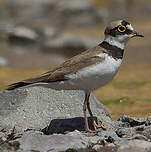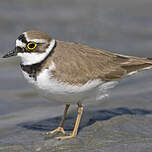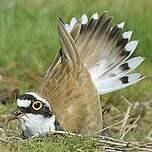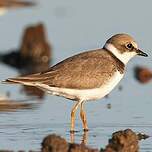Little Ringed Plover
Charadrius dubius - Petit Gravelot Pluvier petit-gravelot
Identification
The Little Ringed Plover looks like the large ringed plover, but it is smaller and has a more delicate silhouette. You must look at the head to make the distinction. First of all, the Little Ringed Plover adult has a striking bright yellow eye ring around its dark eye. Then, its beak is blackish apart from a very small area of dull yellow at the base of the lower mandible. Its forehead is more black than white. Close up, one can very well see a thin white border behind the black forehead band. Finally, its legs are pinkish to brownish. In flight, it has no white wing band, just an alignment of light points at the end of the coverts, barely visible. It's also the only plover without it. Sexual dimorphism is low. The female has brown infiltrating into the black, particularly at the level of the ear coverts, the yellow eye ring is less thick and the legs more subdued in colour. The inter-nuptial adult has the black areas of the head becoming brownish, the pectoral band reduced. The yellow eye ring is still clearly visible. The juvenile looks like the winter adult but the upper tectrices are edged in beige giving them a somewhat scaled appearance. The head, quite uniform, does not show a pronounced pale eyebrow. The pectoral band is often incomplete, cut in the middle. The legs are coloured yellow, which brings them closer to those of the large ones which are more orange. 3 subspecies are described which differ from each other only slightly.
Subspecific information 3 subspecies
- Charadrius dubius dubius (Philippines to New Guinea and the Bismarck Arch.)
- Charadrius dubius curonicus (n Africa, Europe, Asia. except sc and se.)
- Charadrius dubius jerdoni (India to s China and Indochina)
Foreign names
- Petit Gravelot,
- Chorlitejo chico,
- borrelho-pequeno-de-coleira,
- Flussregenpfeifer,
- kis lile,
- Kleine Plevier,
- Corriere piccolo,
- mindre strandpipare,
- Dverglo,
- kulík riečny,
- kulík říční,
- Lille Præstekrave,
- pikkutylli,
- Kleinringnekstrandkiewiet,
- corriol anellat petit,
- Vatnalóa,
- sieweczka rzeczna,
- upes tārtiņš,
- mali deževnik,
- Малый зуёк,
- Cerek kalung-kecil,
- コチドリ,
- 金眶鸻,
- นกหัวโตเล็กขาเหลือง,
- 小環頸鴴〔金眶鴴〕,
Voice song and cries
Habitat
The Little Ringed Plover breeds on the banks or sandy or stony islets of rivers and water bodies, natural or artificial (ponds, lakes, reservoirs, gravel pits, sand pits, settling basins, dykes and embankments, industrial wastelands).
Behaviour character trait
Dietfeeding habits
The Little Ringed Plover is an insectivore. It hunts visible prey on the ground and with its beak those which are not directly visible because they are hidden or buried.
Its diet mainly consists of insects such as beetles, flies (particularly larvae and pupae), ants, mayfly larvae, dragonflies, caddisflies, crickets and grasshoppers, caterpillars, and spiders, amphipod crustaceans, small molluscs and worms. It sometimes hunts by tapping its foot on the sand or mud to provoke a reaction from the prey hiding there. Some vegetable elements can be consumed, such as grass seeds, but this may be unintentional.Reproduction nesting
In Europe and North Africa, the breeding season ranges from March to July. In France, nesting begins in April.
As soon as he returns to his territory, the male performs spectacular nuptial flights during which he beats his wings slowly, swings from side to side, and emits his cries that will evolve into singing once the female has joined him. He courts the female on the ground, leaning towards her, wings open and tail spread in an attempt to impress and seduce her better. The male visits several potential nesting sites in different locations and the female chooses the one that suits her best. She surrounds it with pebbles, shell pieces, or bits of grass, then lays 4 yellow-sand-colored eggs spotted with brown-black. The two adults take turns incubating at intervals ranging from a few minutes to several hours. Incubation takes 22 to 26 days. The chicks hatch in sync, covered in cryptic down that already shows the species' white collar. The adults take care of them for three weeks, until they can fly. Some couples, in particular those that live in the southern part of the range, have time to raise a second brood.Geographic range
The Little Ringed Plover of the eurasian subspecies nests from the British Isles, France and Spain (except Ireland) to the Russian Far East, Korea, eastern China and Japan. It is also in North Africa and the Canary Islands. It winters in Africa south of the Sahara. The jerdoni subspecies is sedentary in the Indian subcontinent and SE Asia. Finally, the nominate subspecies dubius is sedentary in the Philippines, Papua New Guinea and the Bismarck archipelago.
Threats - protection
IUCN conservation status
concern
in the Wild
threatened
evaluated
This species is not listed as threatened by BirdLife International with the criteria used. Nevertheless, the overall population trend seems to be decreasing, although data is lacking in many regions. In Europe, it is estimated that the population size has decreased by at least 25% over 15 years (BirdLife International 2015). The species is mainly threatened by the degradation and loss of its optimal habitats. Many of the breeding sites are disturbed by human recreational activities. On a global scale, the threats are numerous, as one can imagine, regulation of floods, pollution by oil and derivatives, abstraction of fluvial and alluvial materials, pumping causing decreases in water flow, etc. Little Ringed Plover is also affected by these threats.
Sources of information
- IOC World Bird List (v14.1), Gill, F and D Donsker (Eds). 2024-04-18.
- Limicoles, gangas et pigeons d'Europe, Paul Géroudet (mise à jour Georges Olioso)
- Shorebirds, an identification guide to the waders of the world, Peter Hayman, John Marchant Tony Prater
- Avibase, Lepage Denis
- BirdLife International, BirdLife International
- Birds of the World, The Cornell Lab of Ornithology
- xeno-canto, Sharing bird sounds from around the world,
Other sources of interest
 Specification sheet created on
19/07/2023 by Jean François
Specification sheet created on
19/07/2023 by Jean FrançoisTranslation by AI Oiseaux.net
published: 16-02-2021 - Updated: 16-02-2021
© 1996-2024 Oiseaux.net
- Accipitriformes
- Aegotheliformes
- Anseriformes
- Apodiformes
- Apterygiformes
- Bucerotiformes
- Caprimulgiformes
- Cariamiformes
- Casuariiformes
- Charadriiformes
- Ciconiiformes
- Coliiformes
- Columbiformes
- Coraciiformes
- Cuculiformes
- Eurypygiformes
- Falconiformes
- Galliformes
- Gaviiformes
- Gruiformes
- Leptosomiformes
- Mesitornithiformes
- Musophagiformes
- Nyctibiiformes
- Opisthocomiformes
- Otidiformes
- Passeriformes
- Pelecaniformes
- Phaethontiformes
- Phoenicopteriformes
- Piciformes
- Podargiformes
- Podicipediformes
- Procellariiformes
- Psittaciformes
- Pterocliformes
- Rheiformes
- Sphenisciformes
- Steatornithiformes
- Strigiformes
- Struthioniformes
- Suliformes
- Tinamiformes
- Trogoniformes

